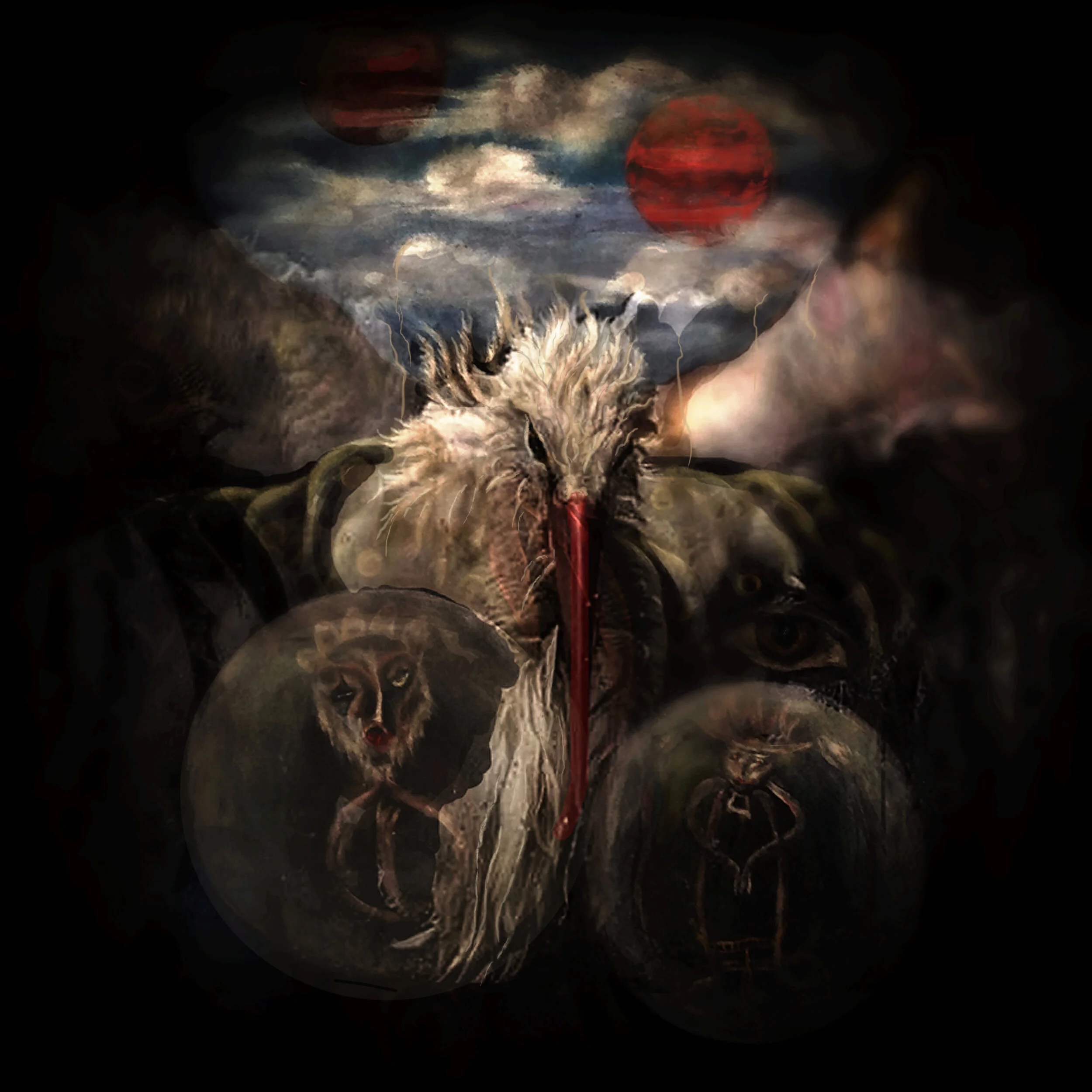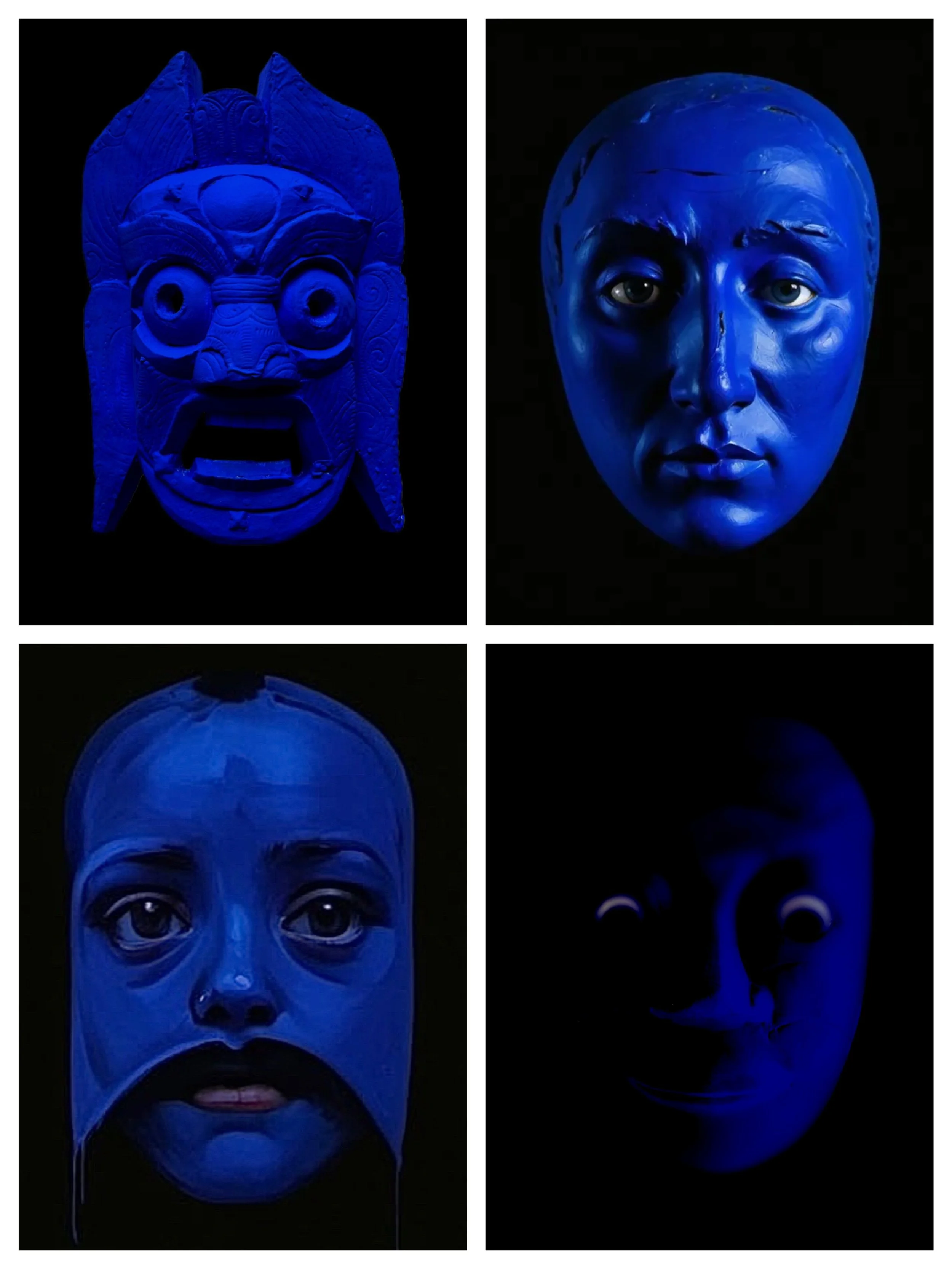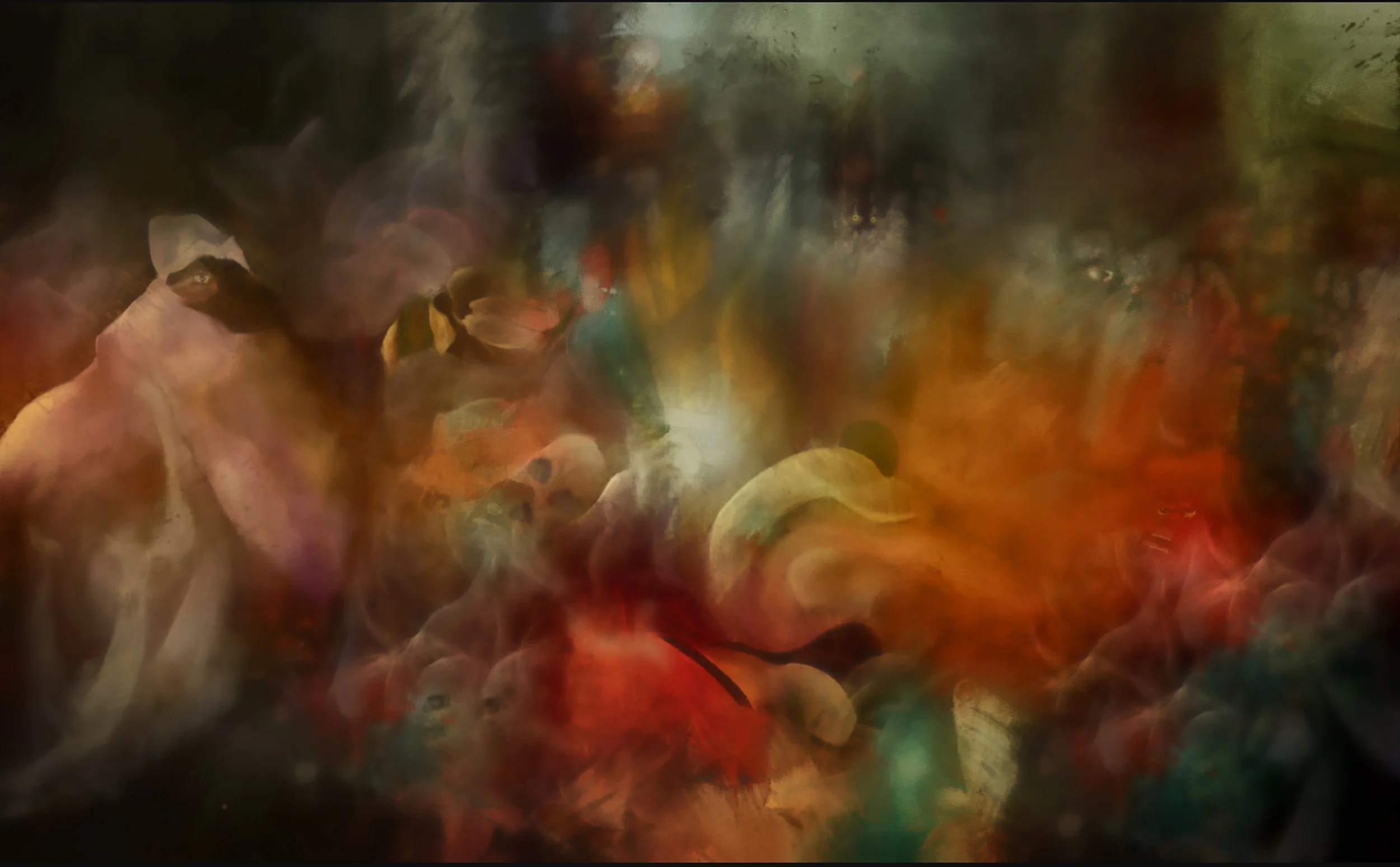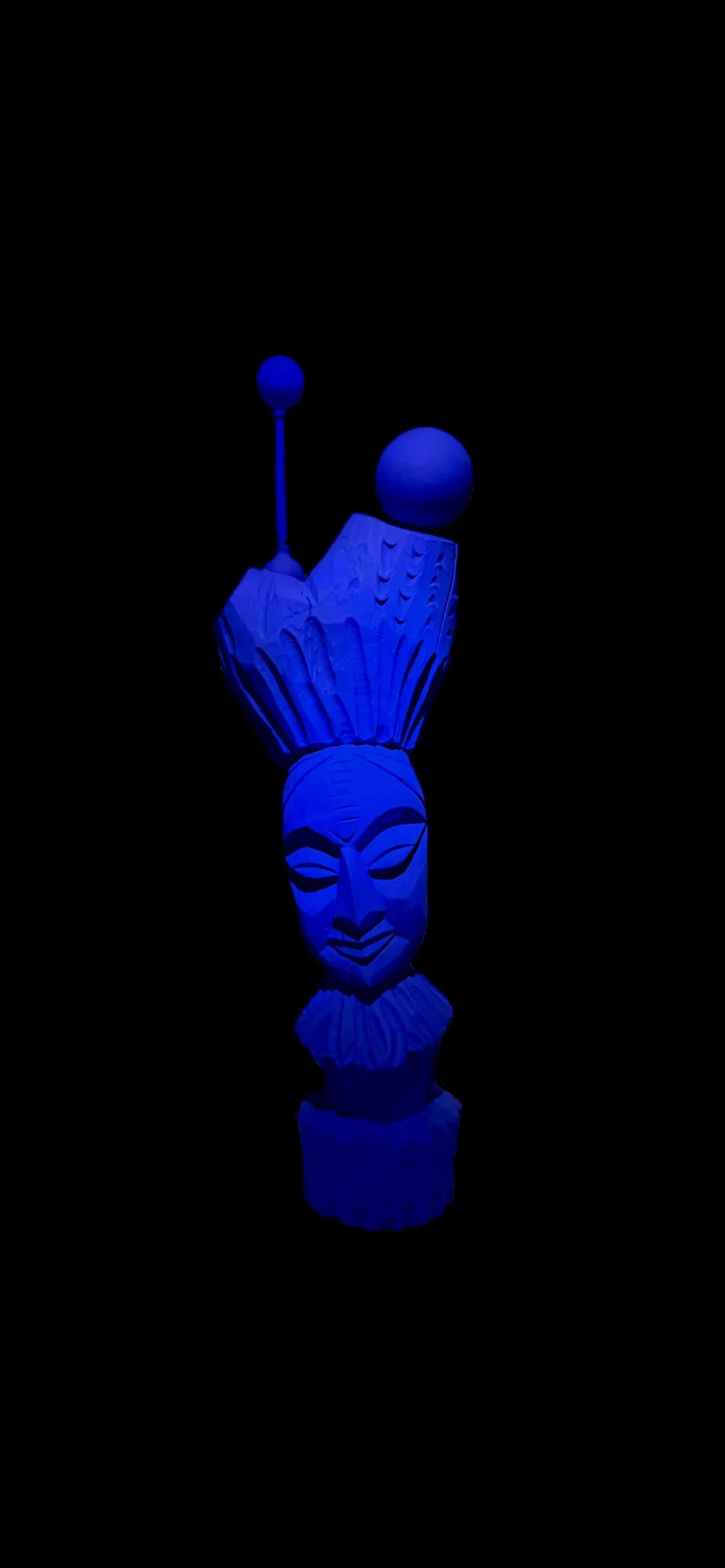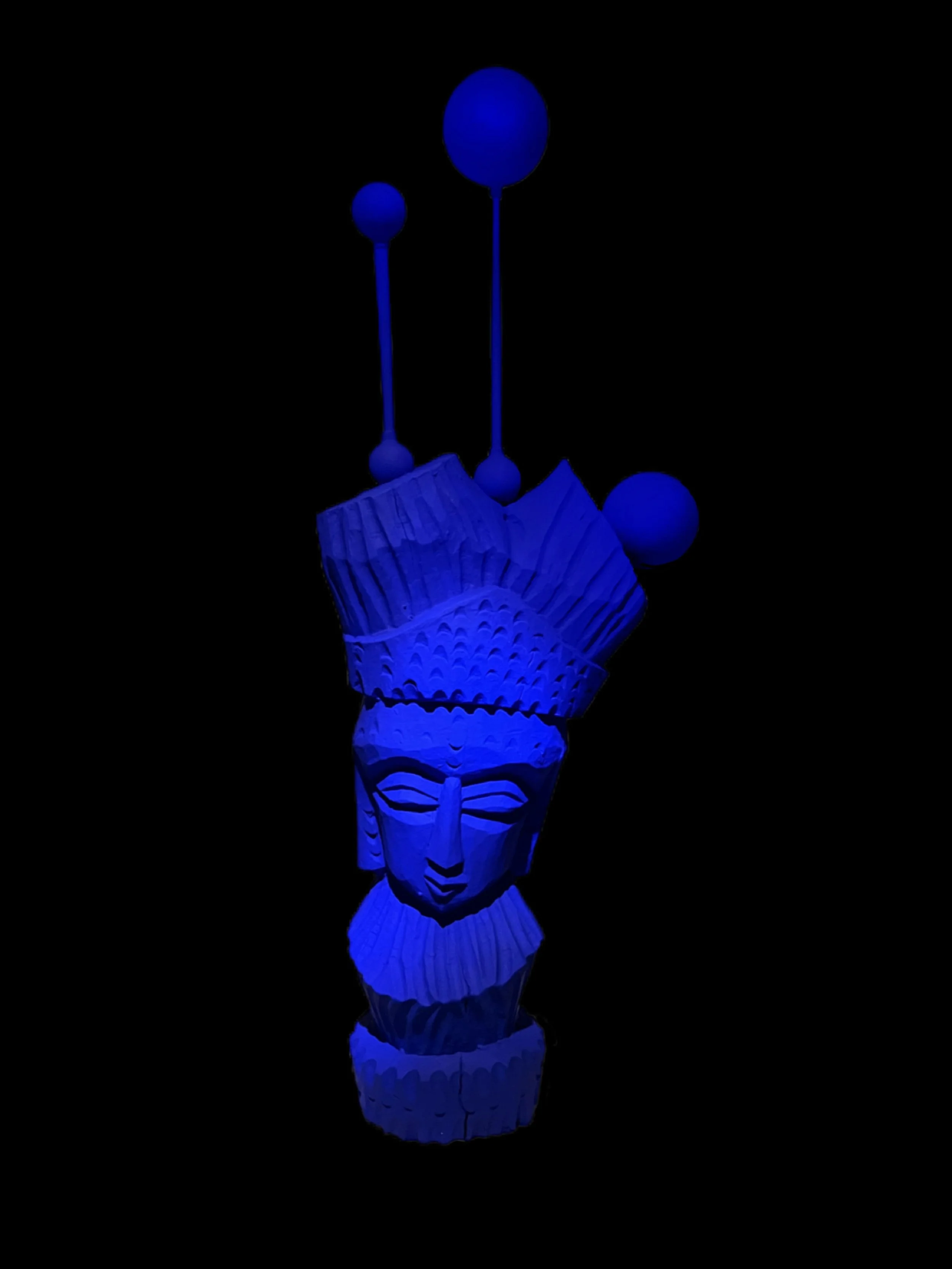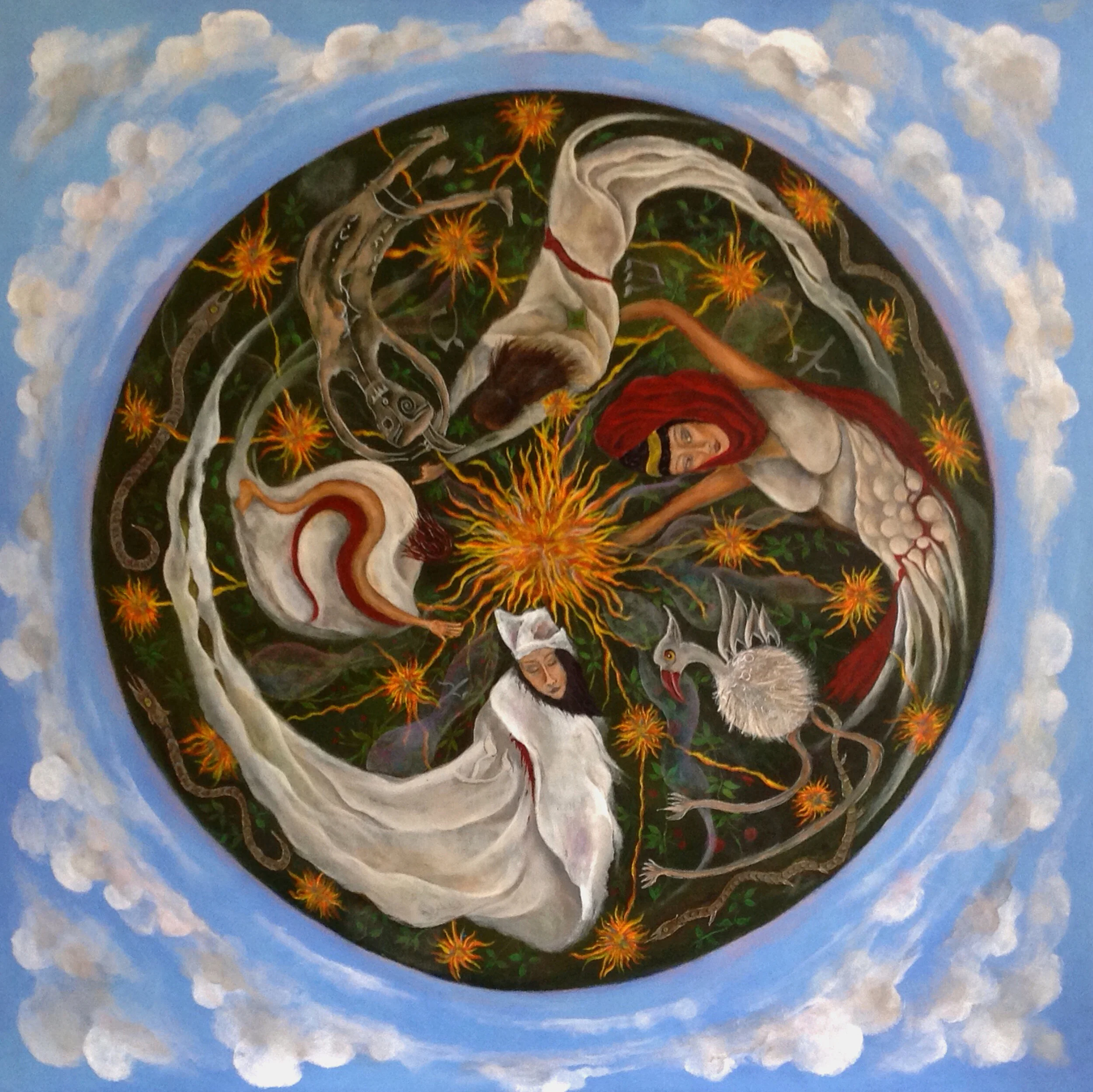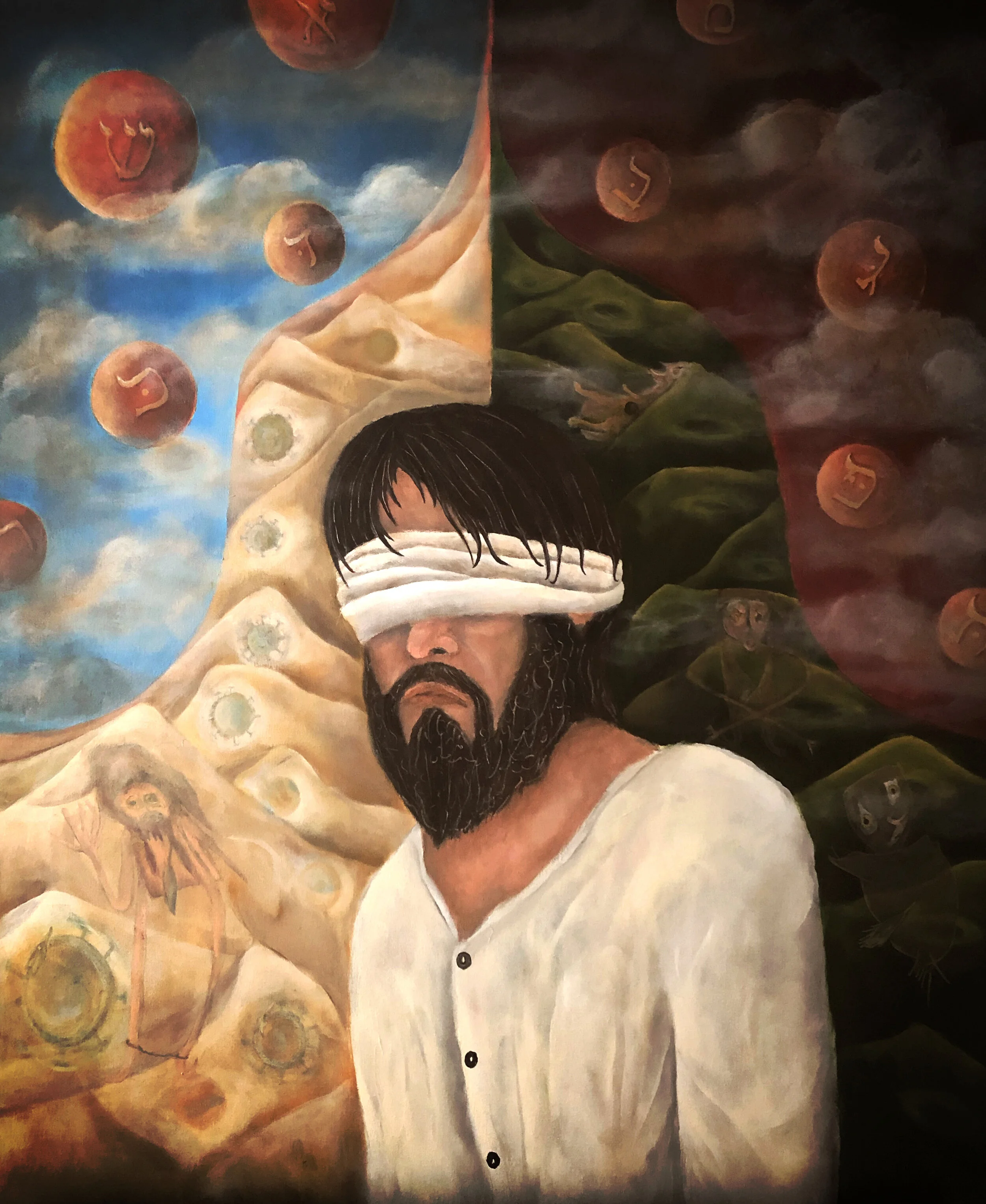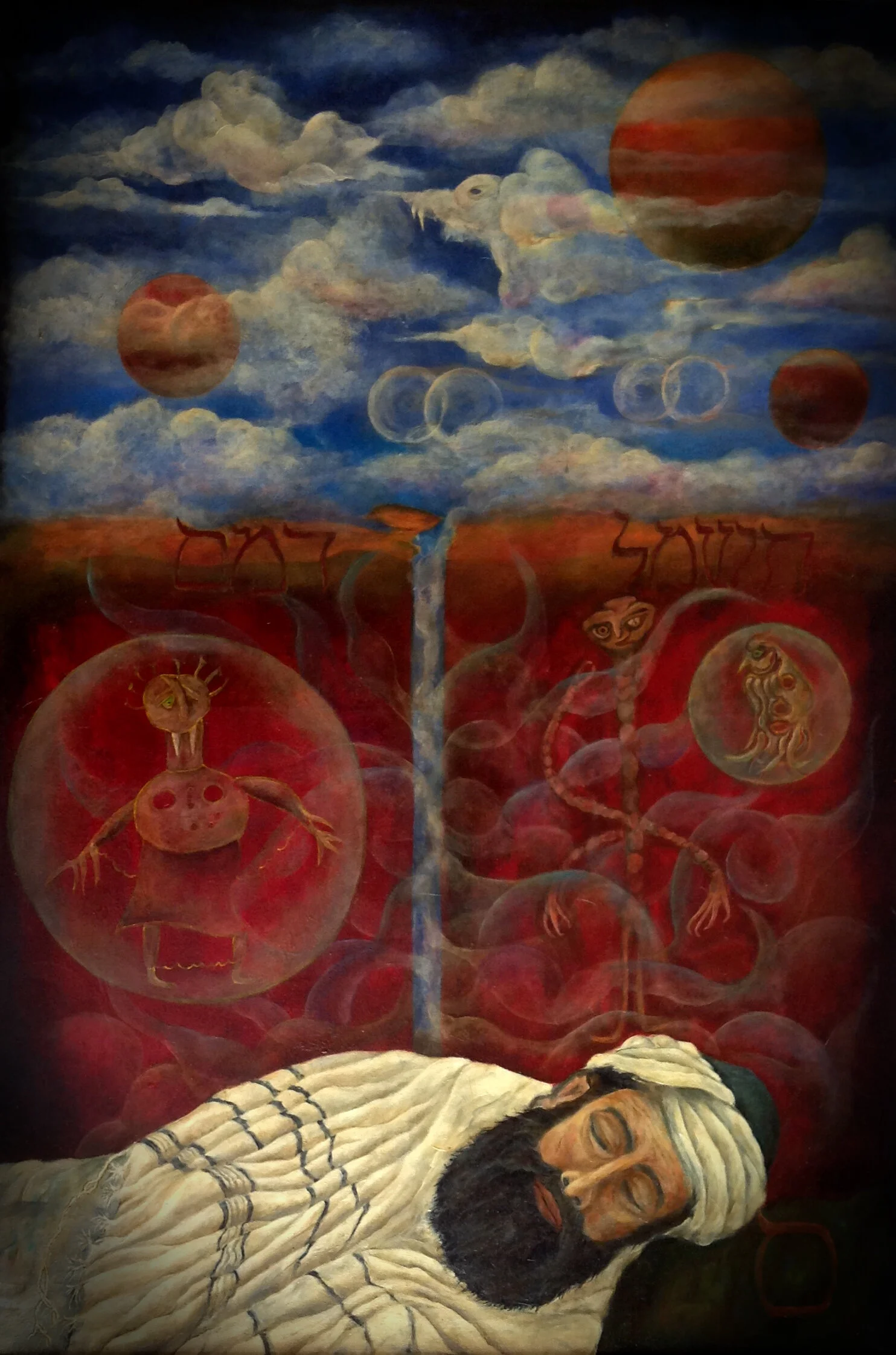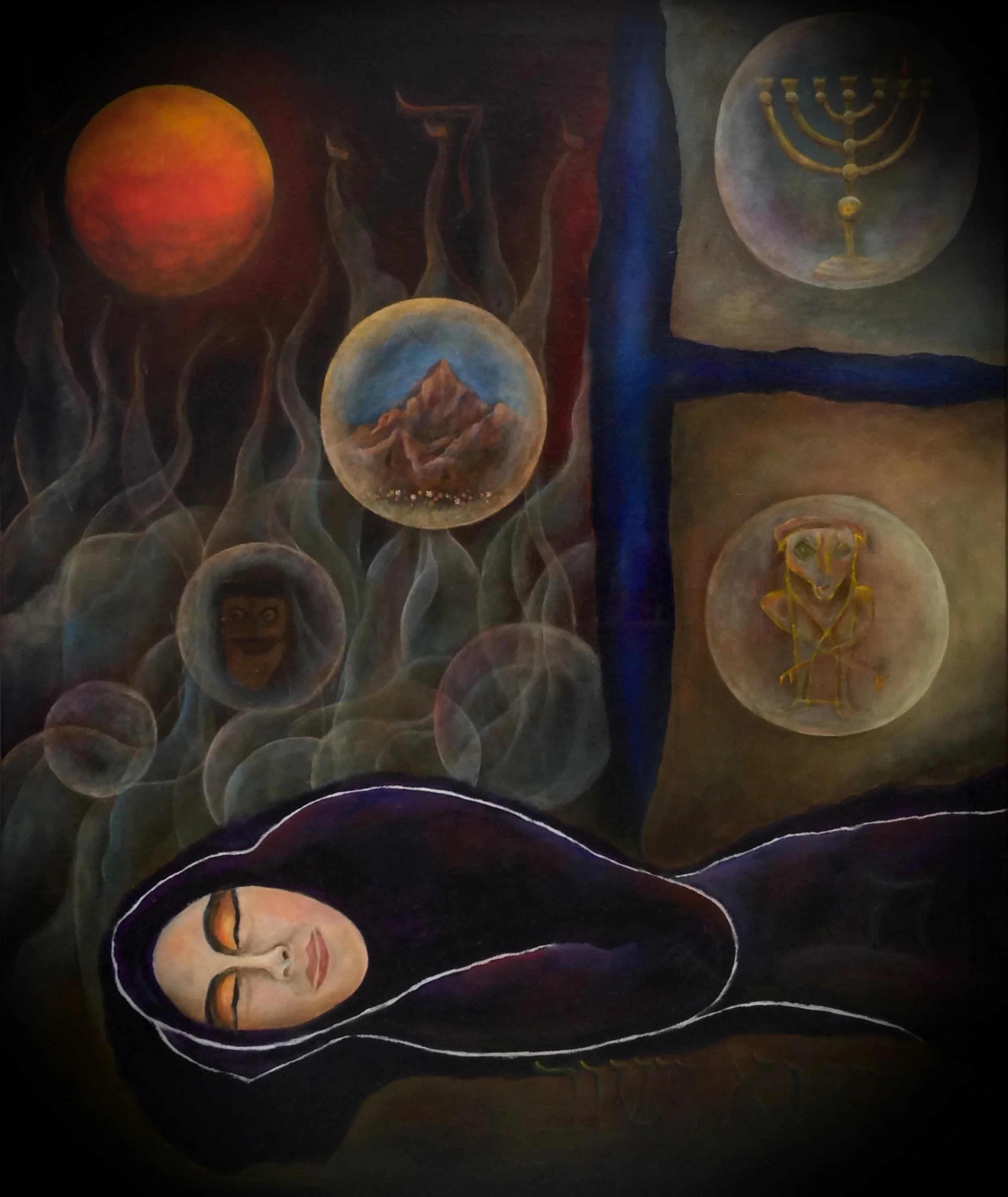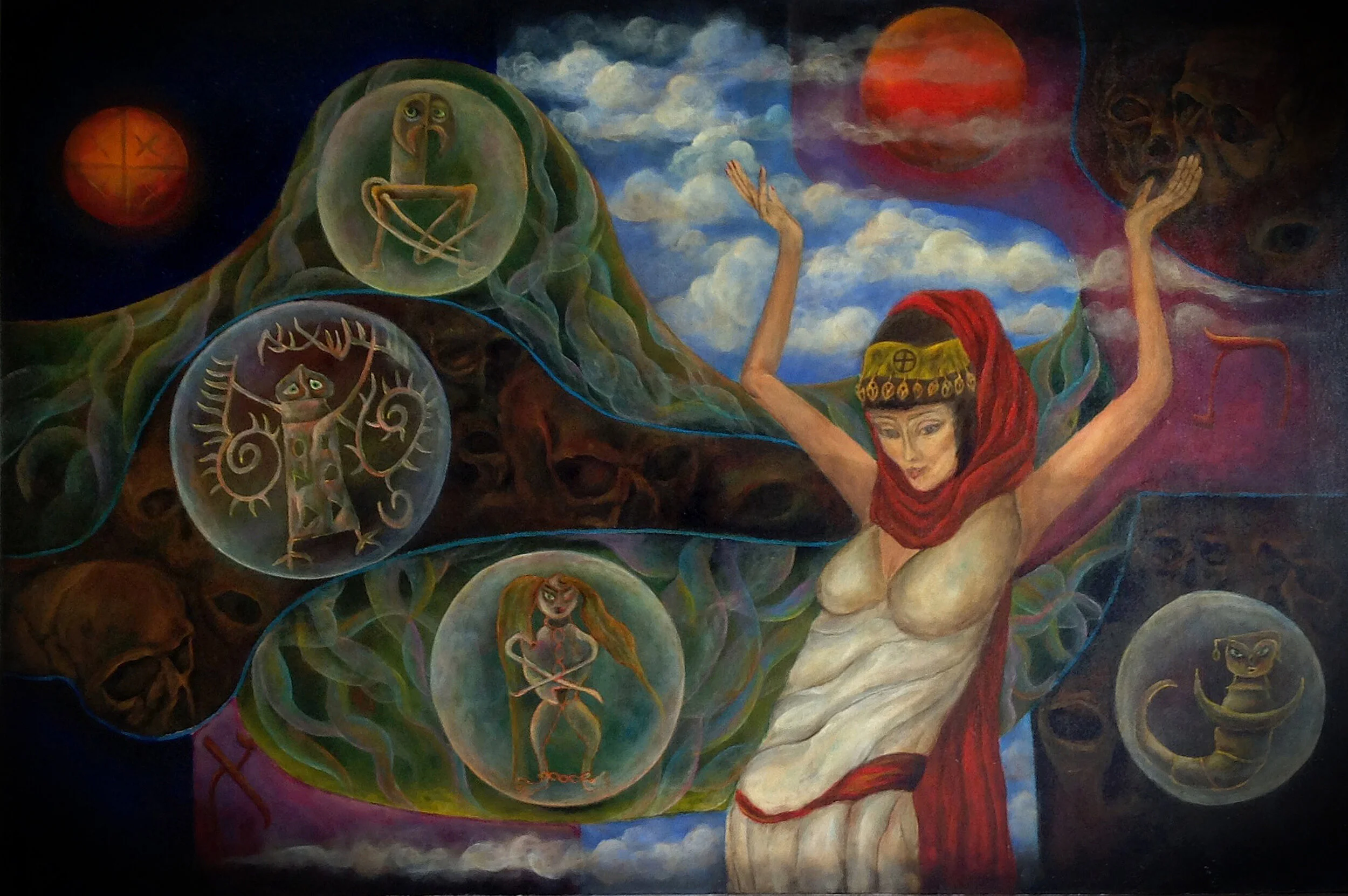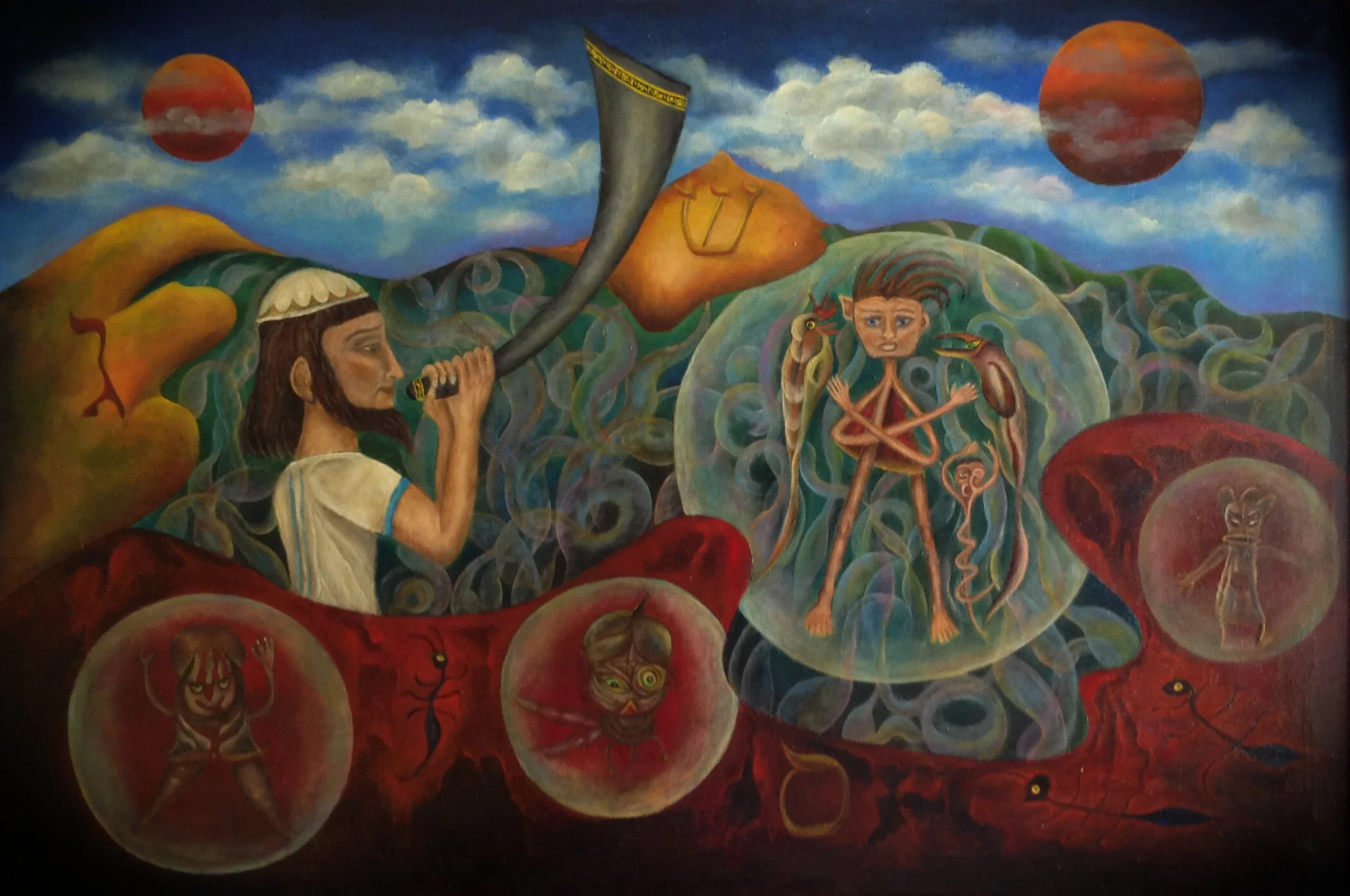AUGURY
Title of the work “Augury” is a reference
to the ancient Roman practice of prophecy
through watching birds.
Observe the birds
and we can see the future.
Thermometer of the earth’s biosphere.
Harbingers, sentinels.
Birds are the first to send signals,
warning us of the frightening state
of our changing environment
and rapidly vanishing world.
The angel of history
A face that looks aghast.
Inspiration for this art work
is the concept of the Angel of History
by philosopher Walter Benjamin
who pictures history as the appearance
of an angel with its face turned towards the past.
Where we perceive history as a chain of events,
the angel sees one single catastrophe
that keeps piling up wreckage
and hurling itself at the angel’s feet.
The angel would like to stay,
awaken the dead,
and make whole
what has been smashed.
But a storm is catching the angel's wings
and violently propels
the Angel of History into the future,
backwards -
this is what we call progress.
The painting “Angelus Novus” by Paul Klee
and a poem about it by kabbalist
and philosopher Gershom Sholem
morphed Europe’s darkness of the 1930s,
for the fearful Walter Benjamin,
into this contracted perception of history.
Here we see the different faces
of the Angel of History,
once again looking backward,
in absolute horror:
a catastrophic event has taken place
and the rubble is going skyward.
The RUPTURE
At dawn,
the music stopped.
Evil unleashed.
The past was now, the future died.
Again the vessels were shattered,
the shards slashing our veins.
When can things be made whole again?.
The artist brings to mind the parable
of the world’s creation
through the kabbalist concept of “Tikun Olam”,
where life’s evolution is a perpetual process of repair.
Through the painting’s haze
the viewer discerns mayhem,
figures cowering.
A ghostly appearance
washes over the whirling chaos,
alluding to darker forces,
carried by the Hebrew letter of Ayin.
“Ayin” is also the word for ‘eye” and “spring”.
Natural springs is where the ancients believed
the earth to be crying and producing tears.
A rupture in time and space,
on that day the earth cried.
TREE OF LIFE - CHOKMAH - UNDERSTANDING
The deep ultramarine pigment,
suffused with an ethereal luminescence,
cascades gracefully from the sculptures,
imbuing the composition with a sublime, otherworldly glow.
In today's climate of uncertainty and upheaval,
there is a profound yearning for enduring values and certainties,
a sentiment poignantly mirrored
in the representation of the ten Sefirot,
or aspects of consciousness, within the Tree of Life.
These aspects—Justice, Understanding, Wisdom,
Strength, Endurance, and Love—serve as pillars
of spiritual and moral grounding.
The sculptures depict
the inherent polarity within the Tree of Life,
showcasing the dynamic interplay between
the male and female principles,
Binah and Chokmah.
Wisdom and Understanding.
This duality is captured through an evocative interiority,
manifesting the spiritual essence of the figures
in their contemplative expressions and poised stillness.
The female head, symbolising "Wisdom,"
and the male head, embodying "Understanding,"
both illustrate their intrinsic connections to the other Sefirot.
These connections are visually represented by orbs
that emanate from each head,
symbolising the interconnected spheres of consciousness.
Through this blend of form,
colour, and symbolic depth,
the artist not only celebrates
the metaphysical dimensions of human experience
but also offers a meditative respite
from the chaos of contemporary existence.
TREE OF LIFE - Binah - Wisdom
FIRESTORM
"Firestorm" is inspired by the works
of 17th century
scholar and artist Athanasius Kircher,
where he presented an image
of a subterranean world in flames.
The painting “Firestorm” is an ode
to his prescient vision.
Here Kircher's subterranean world
is our current earth -
swirling faster and faster,
fires erupting everywhere,
in a spin
that can almost no longer be halted,
with the calm skies
of the universe surrounding it.
Blindfold, and Hid
In the painting "Blindfold, and Hid"
the artist draws on imagery emerging
from his subconscious and personal emotions;
and upon literature, spiritual folklore
and religion to create a contemporary narrative;
one which contains multiple readings,
and which highlights
the deeply unsettling events of our time.
Night is falling over a fertile land,
strange creatures lurk everywhere,
orbs tumble through the skies,
spiked viral shapes dot desert mounts;
the blindfolded protagonist finds himself trapped
in a mystifying landscape
that reflects his demons, fears and uncertainties.
The work’s title “Blindfold, and Hid” refers
to the poem “Hyperion” by John Keats.
Written in 1818,
as he watched his beloved 19 year old brother
slowly die from tuberculosis,
Keats frames the human experience
of suffering and death
with a personal quest for truth,
knowledge and understanding.
Blindfolded:
it's the year 2021,
isn’t this how we all feel?
First Swirlings
Inspiration for this work is the concept
of the Tree of Life.
The painting “First Swirlings” is a reference to
the ancient Jewish “Book of Splendor”
(the Zohar)
and represents a lower branch
or stage within the Tree
with its ten ‘fruits’of self-realisation,
or even enlightenment.
Where the Tree of Life
usually is depicted in its entirety
and with a sacred geometry,
this painting focuses on just one
detail of the Tree of Life.
Suggesting a metaphorical climb into the Tree,
it imagines the swirls, chaos and
dissolution of thoughts that first appear
when searching for mental solace
through meditation.
An anthropomorphic creature
materialises from the left,
giving the impression of an attempt to traverse
the whirling, stormy landscape.
Other figures are in a meditative pose,
unaware of the looming presence behind them
that will eventually overwhelm them,
finishing their altered state of consciousness.
The colour patterns can be interpreted
as phosphenes -
the colours and shapes that float around
when we close our eyes during meditation.
Certain shapes
can also be seen referring to fertility,
as the merging of bodies
into a non-defined entity,
and in this particular context,
as thoughts
being born,
and whirling
through our ‘monkey mind’.
BOUNDLESS
Principal topic of the work “Boundless”
is the unmooring of consciousness.
The male figure is already
in a deep meditative state.
Ascent towards the next stage
by the painting’s protagonist
presents itself through a narrow passage,
almost like an air shaft,
flanked on either side by strange creatures
that represent some of life’s tribulations,
ready to distract the mind traveler.
In the stormy clouds the viewer can detect
a faint reference
to the Book of Ezekiel
that describes a celestial chariot,
signifying further ascent,
as well as enhancing
the work’s mystical resonances.
The Hebrew word on the painting
translates as “humming”
and refers to Ezekiel’s text
where a humming sound is mentioned
as part of the ecstatic process.
OSCILLATION
“Oscillation” was created in juxtaposition
with the painting “Boundless”,
with both figures depicting
the different aspects of the brain:
intuitive understanding versus wisdom.
Our brain ‘oscillates’ between the two,
feeding off each other.
The female figure in this work finds herself
in a progressing state of deep contemplation,
although the brain is still spawning ideas
and images, such as the guiding light
from a candle by a setting sun,
a demon creature
with its hands and legs already tied,
a flowered valley
crowned by a pure blue sky
and thoughts swirling
into the Hebrew letter Shin,
often linked to the concept of “Binah”.
In kabbalist literature, the name “Binah”
is given to Wisdom
and represented by the female figure.
The blue lines in the painting
flowing from and towards her
connect the woman to other parts of the brain
and are inspired
by a verse from Genesis (2:10)
“A river issues from Eden to water the garden.”
However centered on the complex concept
of understanding,
“Oscillation” also signals
the importance of personal transformation
through contemplation and meditation,
with imagery that intends to transcend
its religious and pseudo-religious roots.
The painting’s muted color palette
simultaneously creates a sense of stillness,
as well as serving to reinforce
the mysteries of the brain.
EXALTEDNESS
In the work “Exaltedness” a feminine figure
seeks mental freedom and enlightenment
through movement and dance,
slicing through
different spheres in the brain
and even celebrating
the many obstacles in life
as depicted in the painting’s translucent orbs.
The feminine power as such represents
the top of the Tree of Life
in kabbalist literature
and is considered the ever-renewing
cyclical flow of natural times and seasons.
The dark areas in “Exaltedness” refer
to death and renewal,
whereas patches
of earth, night and day
all work to create a sense of shifting dynamics.
The figure in the painting is at once sensual,
ecstatic and melancholic, with garments
that accentuate the flow
of her movements and power.
Although the characters in the artist's work
are often based on a human framework,
they actually represent
various states of the mind.
However, the viewers are encouraged
to make their own associations
between images and abstract patterns.
WONDROUS
Occupying a space between the subconscious
and physical reality,
the painting “Wondrous” presents a mind journey,
where a figure progresses through a succession
of subliminal realms.
Related to the artist’s interest
in the directionality of language,
the Hebrew writing is the key
to tracing the path
etched out in this composition.
From right to left,
the viewer sees four realms
that allude to the traditional kabbalist principle
of the Four Worlds,
embodying dimensions of consciousness
in the human experience.
Cloaked in a garment
that suggests a quest for the sublime,
the figure wanders from a moonlit garden
into a dimension of smoke and fire.
He cautiously touches a translucent orb,
where two humanoid creatures
with their legs bound tumble around.
The artist draws on imagery
from ancient Aramaic incantation bowls
that offered protection from evil and bad luck,
to guide the painting’s protagonist
through a kaleidoscope of his subconscious.
In an adjacent nocturnal dimension
he is about to encounter the “Teli”,
the most mysterious word
in ancient kabbalist literature,
widely understood as the confluence
where the physical and spiritual meet
and you ascertain your balance,
sometimes depicted in a snake-like form.
A spirit-like apparition vanishes
into the background,
with ankles chained,
unable to fully crystalize,
not more than just a fleeting thought.
The end of the journey is a golden sunrise
in a powdery blue and white realm,
calm and finally settled.
SHABBETAI TZVI AND HIS THIRD WIFE ARE ABOUT TO RULE THE WORLD
Mysterious, menacing and grotesque,
in “Shabbetai Tzvi and his Third Wife
are about to rule the World”
the artist presents the viewer
with a phantasmagorical composition,
where a man and woman perform
an act of levitation and balancing,
in utter stillness,
set in a turbulent landscape
that can only exist in the realm of painting.
Inspiration for this work
is the bizarre tale of the charlatan Shabbetai Tzvi,
who in the 17th century
took the Jewish community by storm,
claiming that he was
the long awaited Jewish Messiah,
only to leave behind a baffled world
when he converted to Islam.
Reminiscent of the geometrical shape
of the Tree of Life
with the translucent orbs and planet-like circles,
the protagonists are placed
in the middle of the composition,
referring to the core
of Shabbetai Tzvi’s belief
that the Kabbalah identifies God
as the Sefira of Tiferet,
located at the heart of the Tree.
Prone to delusions,
mentally ill
and eccentrically behaved,
Shabbetai Tzvi found himself propelled to fame
by a group of people,
enablers
that instrumentalized his madness
and apparent charisma
to become a powerful force
in the Jewish community across the world,
whilst leaning on his third wife Sarah,
an equally peculiar woman.
In this composition the imagery
becomes dislodged from its origins
in ancient Kabbalistic magic books
and other mystical objects
and is presented as a parable
of our present era of personality cults,
religious fanaticism and destructive populism
that leave nothing but a scorched earth.
TRANSFORMATION
The artist:
"My attention was caught by a hoax
that surfaced on the internet:
people all around the globe allege hearing
mysterious blasts of sound coming from the sky.
Clarion calls,
that some identify as angelic trumpets
announcing the end of the world,
others believe they recognize the Jewish shofar
or ram’s horn with similar dark warnings.
I also heard the shofar, in the Negev desert,
but blown by a real person.
A call for transformation in Jewish tradition,
it heralds for example the new year
and marks Yom Kippur.
Around the same time I saw in Jerusalem
an Aramaic incantation bowl,
black magic clay bowls
from the Babylonian era,
with an illustration
of several strange figures and shapes.
Working on the concept of Transformation,
these three separate impressions merged
into the subject and imagery for this painting.
Desert land
creeping up on the green land,
a hot netherworld rising with mad insects,
a green world full of swirls signifying flux,
I intended to create a cry of urgency
with the horn about to be blown forcefully,
with two firm hands.
The clay bowl’s depiction I reworked
into a person and a child, flanked by two birds,
aggressively telling it something urgent.
The person makes a protective gesture,
the child is fearful:
nature has a message,
something is happening.
The Hebrew letter Gimel, however,
carved in the desert
indicates that humanity can overcome
the crossing of the desert
and the letter Samech
in the red hot zone
offers hope."
CONCEALMENT
A rich, atmospheric sky augments
the psychologically-charged mood,
adding to the impression
of an almost theatrical gesture
by the painting’s protagonist warding off
the translucent orbs swiveling around him
and closing his eyes to an angelic apparition
concerned with matters beyond the composition.
The scene is set in a landscape reminiscent
of a memory or a dream,
where two mountains
reflect a primordial red earth
that gives way to tilled fertile land,
stretches of desert
rendered in knotted ribbons of sand
that appear on the move,
with underneath a murky earth
restless with faint smokey swirls.
The disharmony in the landscape
conjures associations
with different climate spheres,
intimating a sense of instability.
The title of the work suggests the truth
concealed from the protagonist
is revealed as the truth
that remains concealed:
an earth in flux inadvertently hurtling
towards an outcome that nobody wants.
We are unable,
even unwilling to fully grasp the process,
but nevertheless aware
that something is happening.
Drawing on imagery
found on Aramaic incantation bowls
and in ancient magic books,
the characters depicted in their translucent orbs
serve to create an almost talismanic painting,
imbued with protective powers.
MY SHADOW TALKS
The artist:
“Political engagement is not my habitual topic,
but this work intends to highlight
the duality of our psyche.
It was an article by Deepak Chopra
that inspired me,
where he describes present day politics
as dominated by ‘the Shadow’.
A Jungian concept, with its origins by Freud,
the ‘Shadow’ is our bad self
with all its dark impulses
that must remain hidden.
We need to learn how to control
and suppress our shadow self.
But in the current political climate
the Shadow is encouraged to come out,
it even dominates.
We appear to live in an age of denial,
where the shadow is allowed to talk too loudly
and our conscious self hangs its head
in an almost desperate silence.
In this digital collage two identical figures
emerge from the darkness;
where the man on the right is clearly speaking,
the protagonist on the left appears subdued
and marginalized, disappearing in a haze.
A tribal warrior shroud from Papua New Guinea
is superimposed onto the Shadow,
as he manages to push the Conscious Self
to the background, even rising above him.
The collage is based on one of my own works,
the same figure appears
in the painting “Boundless”.
The protagonist displays his duality,
no longer able
to keep his Shadow hidden from sight.”
DANCE IN THE GARDEN
In “Dance in the Garden” the protagonist
from the painting “Exaltedness”
is reimagined in a digital collage.
In addition to the kabbalist concept
of celebration of the universal female aspect,
this work pays homage
to the theories of George Ivanovich Gurdjieff,
in particular those with regard to
dance and movement.
Gurdjieff developed a philosophy of humanity
living in a state of hypnotic sleep
and the ability to awaken,
to reach a state of higher consciousness.
One of his methods was awakening
through music, dance and movements.
In this work the female figure’s dance
is similar to one of “Gurdjieff’s Movements”.
She is wrapped in strings of flowers,
adorned by the beauty of nature,
yet the garden’s bounty is juxtaposed
against the dark night,
where the air is charged
with dangerous electricity,
already striking her and the flowers.
There is an urgency to her dance,
a need to awaken to counter the darkness
and preserve the beauty.
Night has descended on the Garden
and she must find her way
to the renewing daylight.
The flowers
are digitally repainted photographs of roses
and the protagonist’s smile from “Exaltedness”
has faded into a more pensive look,
deeply concentrated on her movements.
“Don’t worry, I’m not human the thought form said to the amulet”
In “Don’t worry, I’m not human,
the Thought Form said to the Amulet”
the characters are borne of imagery
from ancient kabbalist magic objects
and of the artist’s imagination.
The title indicates
that the figures in the composition
fulfill archetypal roles,
related to the theosophical theories
of Annie Besant and her circle.
Besant's esoteric concept of ‘thought forms’
and their visualization through color schemes
that correlate with human emotions,
mirrors similar kabbalist theories
about the correspondence between
emotions, colors and character.
Isolating certain elements from both,
this painting brings
together two widely different disciplines
in one mystic dystopia.
Cloaked in colors that according to
Besant’s ‘thought form’ color scheme
signify high spirituality (purple),
deep intellect (orange),
sympathy (green)
and devotion (blue),
an aged man-like figure is about to emerge
onto a turbulent stage.
Reminiscent of a theatre
where the curtain just lifted,
the central stage is dominated
by a creature derived from
an antique practical Kabbalah magic book,
donned in colors that represent
a house of spells (orange),
power (red) and victory (green),
referencing more contemporary
kabbalist color theories.
Shaped with a body that suggests
a closed gateway,
possibly to an occult fun fair,
the talismanic creature or amulet
welcomes the visitor with open arms,
whilst raising another pair of arms
to emphasize its strength.
Adjacent, a temple-like edifice
offers another doorway,
clearly open,
revealing a blue sky,
but the structure’s muted colors
suggest it might be the less exciting option.
What choice will the protagonist make?
Presenting a panoply of esoteric superstitions
that flourished during an anxious Fin de Siècle,
the artist creates
an almost hallucinatory optical overload
to frame a strange, otherworldly realm
and although caricatural,
reflective of our present world,
where truth and reason are shamelessly ignored;
and we can choose who or what to believe,
albeit at our own peril.
Chaos and void
The painting “Chaos and Void” is a reference
to the ancient cryptic literature of the Kabbalah
that aimed to explain creation and the universe
through the Hebrew alphabet
and the numbers one to ten.
And man’s spiritual evolution
through a system of divine revelations,
imagined in a geometrical pattern
described as the Tree of Life,
encoded in complex arithmetical calculations.
The viewer sees an archetypal man of devotion
throwing his hands up in the air,
seemingly to catch what is floating around him:
orange orbs with numbers
that correspond with the ten sefirot or spheres
within the Tree of Life;
and translucent orbs that trap malefic creatures,
creating a tension between good and evil.
With its tumbling round shapes
“Chaos and Void” suggests
a sense of ephemerality
and instability,
very much like the fluttering mind
in its initial stage of pursuit of life’s great answers,
seeking dialogue with the sublime.
WATERSHED
Even the invocation of superstition
as depicted in the translucent orbs
and the conjuring of a talismanic creature
do not suffice to prevent the earth from tilting;
a humanoid figure grabs its head in despair
and sheds a tear;
the male protagonist
cloaked in white
raises his hands,
signalling an embrace of the spiritual.
In “Watershed” the artist employs
a cast of strange figures
drawn from ancient Aramaic incantation bowls
and kabbalist magic books
within a fantastical environment.
The title suggests an apocalyptic event,
where it may not mean the end of times,
but certainly a dramatic rearrangement
of the world’s order and thought.
The imagery indicates return to an era
where religion and the occult are never far away.
Darkness descends, the earth is in flux.
Hebrew letters swirl around,
signifying their kabbalist meaning
as building blocs of the universe
and deployed to construct a new world.
